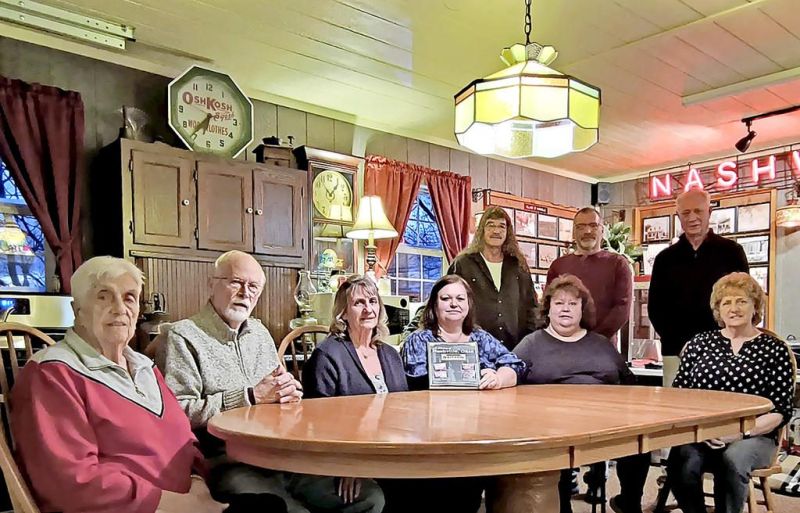Village of Nashville 300-page book now available for preorder
Anyone hunting for local history may enjoy purchasing the first edition of “A History of Nashville, Ohio,” which will be released this spring. Nestled on the west side of Holmes County between Loudonville, Lakeville and Glenmont, the village of Nashville has a rich history that area residents are eager to share.
Spanning 10 chapters, the 300-page hardcover book will feature history leading up to the village’s formation to the present day. Topics covered are the area’s early years, veterans, churches, cemeteries, schools and athletics, village departments, the post office, businesses, community activities, people, places, interesting facts, and memorials.
The project began about a year ago when a group of 10 current and former Nashville residents got together to form a history committee. Neighboring communities including Glenmont, Lakeville, Shreve and Holmesville have published history books recently, and they decided to follow suit.
“One of (the Glenmont history book members) had stopped at the house and said you guys need to do a book on Nashville. There’s a lot of history here,” said Craig Walkerow, a lifelong Nashville resident and committee member.
Walkerow and other residents met periodically to recount their findings.
Nashville was founded in 1828 by proprietor Eliphalet Drake, naming the village after Brig. Gen. Francis Nash, who served in the Continental Army during the American Revolutionary War. Drake laid out a lot survey dated June 6, which was recorded June 30.
The location was chosen because of the then-famous Galloway Road, which Capt. Galloway used during the War of 1812 on his way to Zanesville, intersected with state Route 39, leading from Millersburg to Loudonville. Another crossroads took travelers from Newark to Akron.
“That’s the reason why we ended up right here on the hill,” Walkerow said. “Village on the hill, that’s what they called it.”
The original village housed 31 lots, eventually expanding as the community grew. Today, Nashville spans 0.08 square miles, with a population of just under 200, according to census reports.
In its heyday Nashville was home to all necessary stores and businesses, as people didn’t venture as far from the community, said Cheryl Arwood, committee member.
A popular landmark is the hotel building uptown, which used to be a stagecoach stop. For the last several decades, it has been used for residential apartments. A notable building is the local tavern that now sits vacant downtown. The grange building, which is being remodeled, is another. And just outside the village limits sits Nashville Elementary School, originally the high school. Memorable buildings such as the former fire department and historic schools will be included.
One interesting tidbit the committee found was a June 28, 1917 article reporting Ohio Gov. James M. Cox’s visit to Nashville High School’s dedication, when area schools were consolidated into one school district.
“Making a drive from Columbus here for the dedication would have been quite a deal in its day,” Walkerow said.
During their research the committee utilized the expertise of local schools, churches and resident history buffs. Much of it was word-of-mouth.
“You talk to one person, and they lead you to another person,” Arwood said.
Everyone had his or her own task to research, and soon the body of materials was larger than what could fit in a single book. They limited their focus to a 3.5-mile radius outside the village limits, as the findings continued to grow.
“The fear was at first there might not be enough information, but my gosh, they found a ton of information,” Walkerow said.
The committee aimed for 250 pages but ended up with 300 pages with plans for a second issue at some point.
“(Issue two) will be covering the same type of history,” Arwood said. “We were just not able to get everything in this book. We’ll have a lot of pictures left over that we haven’t used and other information.”
The committee is ordering 1,000 books, printed through Holmes Printing Solutions LLC in Fredericksburg, which will be available for preorder and later purchase. Presales have been going well, with former residents ordering as far as Kansas, Vermont, Tennessee and Florida.
The book costs $25. It can be ordered by writing to Nashville History Book, 11052 Township Road 516, Shreve, OH 44676, or by calling 330-315-2513.
The book is expected to be released in May, and the group will have copies available at the Nashville Memorial Day Parade. The committee plans to sell during other community events in the following months. Additionally, copies will be donated to the Holmes County Historical Society, The Cleo Redd Fisher Museum, County Line Historical Society and Nashville Elementary School.
Walkerow and Arwood are thankful to their fellow committee members who have worked hard to bring this project to life, especially Rosanna Armbrust, who spent countless hours writing it.
“She’s just unbelievable as far as the work she’s done day and night,” Walkerow said.
Armbrust said her work on the project has been one of the most rewarding experiences. She has enjoyed meeting many people, learning their stories and seeing their photographs.
“This has truly been a labor of love, and I am grateful for the opportunity to preserve and celebrate so much of Nashville’s rich history before it becomes a mere memory,” Armbrust said.

